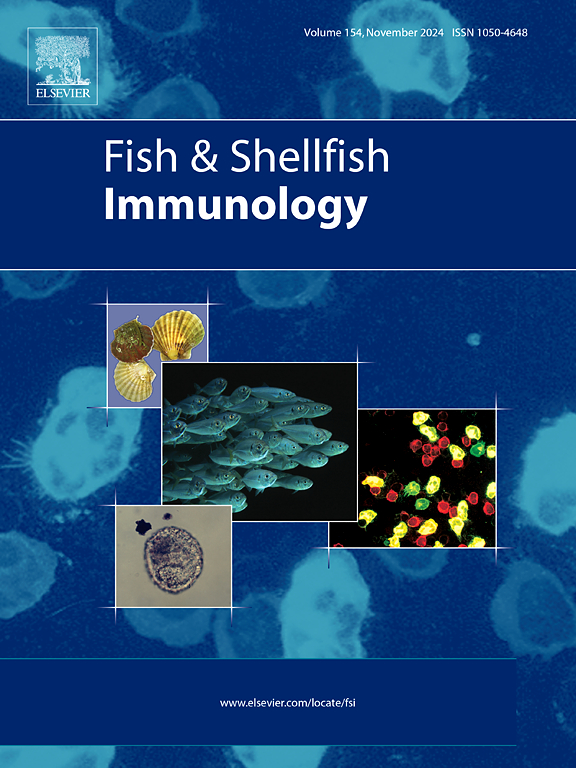medaka (Oryzias latipes) Hsp90ab1的分子特征。
IF 3.9
2区 农林科学
Q1 FISHERIES
引用次数: 0
摘要
神经坏死病毒(NNV)可感染多种鱼类,给世界范围内的水产养殖业造成了严重的经济损失。近年来,大量研究表明热休克蛋白90ab1 (Hsp90ab1)是红斑石斑鱼神经坏死病毒(RGNNV)的受体,但其潜在功能尚未得到研究。本研究鉴定出了medaka (Oryzias latipes) hsp90ab1基因(OlHsp90ab1),该基因包含13个外显子,基因组长度为5191 bp,编码序列为2175 bp。OlHsp90ab1共有724个氨基酸,包含低复杂度区、组氨酸激酶样atp酶区和卷曲线圈区3个区域。系统进化树分析显示,OlHsp90ab1与异交底的同源基因聚类密切。此外,hsp90ab1转录本在所有成人组织中均有组成性表达。RGNNV感染medaka后,hsp90ab1在眼和心脏的相对表达量升高,而在脾脏、脑、鳃、肝脏和肾脏的相对表达量降低。在GE细胞中过表达OlHsp90ab1显著增加病毒基因转录。同时,利用CRISPR-Cas9系统构建medaka突变体OlHsp90ab1△5和OlHsp90ab1△17a。出乎意料的是,纯合突变体(Hsp90ab1-/-)在孵化后2周死亡。此外,杂合子突变体(Hsp90ab1+/-)和野生型(WT) medakas被RGNNV感染。然而,RGNNV感染一周后,Hsp90ab1+/-不同组织中RNA2基因的表达与野鼠相比无显著差异。综上所述,medaka Hsp90ab1在生物体的生长发育中起着至关重要的作用,并参与免疫反应过程,但它不是产生抗rgnnv菌株的合适候选者。本文章由计算机程序翻译,如有差异,请以英文原文为准。

Molecular characterization of the medaka (Oryzias latipes) Hsp90ab1
Nervous necrosis virus (NNV) can infect many species of fish and has caused severe economic losses to the aquaculture industry worldwide. Recently, there is a wealth of research indicating that heat shock protein 90ab1 (Hsp90ab1) is a receptor for red-spotted grouper nervous necrosis virus (RGNNV), however the potential function has not been examined so far. In this study, medaka (Oryzias latipes) hsp90ab1 gene (OlHsp90ab1) was identified, which contained 13 exons with a genome length of 5191 bp and coding sequences of 2175 bp. OlHsp90ab1 had 724 amino acids, containing three regions including low complexity regions, histidine kinase-like ATPases region and coiled coil regions. Phylogenetic tree analysis revealed that OlHsp90ab1 clustered closely with homolog in Fundulus heteroclitus. Moreover, the transcript of hsp90ab1 was constitutively expressed in all adult tissues. Following RGNNV infection in medaka, the relative expression of hsp90ab1 increased in the eye and heart, while decreased in the spleen, brain, gill, liver, and kidney. Overexpression of OlHsp90ab1 in GE cells significantly increased viral gene transcription. Meanwhile, medaka mutants named OlHsp90ab1△5 and OlHsp90ab1△17a were established using CRISPR-Cas9 system. Unexpectedly, homozygous mutants (Hsp90ab1−/−) died 2 weeks post-hatching. Moreover, heterozygote mutants (Hsp90ab1+/−) and wild type (WT) medakas were infected with RGNNV. However, the expression of RGNNV RNA2 gene in different tissues of Hsp90ab1+/− showed no significant difference compared to WT medaka after RGNNV infection within one week. Taken together, medaka Hsp90ab1 plays a crucial role in the organism's growth and development, and involves in the immune response process while it is not a suitable candidate to generate the anti-RGNNV strain.
求助全文
通过发布文献求助,成功后即可免费获取论文全文。
去求助
来源期刊

Fish & shellfish immunology
农林科学-海洋与淡水生物学
CiteScore
7.50
自引率
19.10%
发文量
750
审稿时长
68 days
期刊介绍:
Fish and Shellfish Immunology rapidly publishes high-quality, peer-refereed contributions in the expanding fields of fish and shellfish immunology. It presents studies on the basic mechanisms of both the specific and non-specific defense systems, the cells, tissues, and humoral factors involved, their dependence on environmental and intrinsic factors, response to pathogens, response to vaccination, and applied studies on the development of specific vaccines for use in the aquaculture industry.
 求助内容:
求助内容: 应助结果提醒方式:
应助结果提醒方式:


